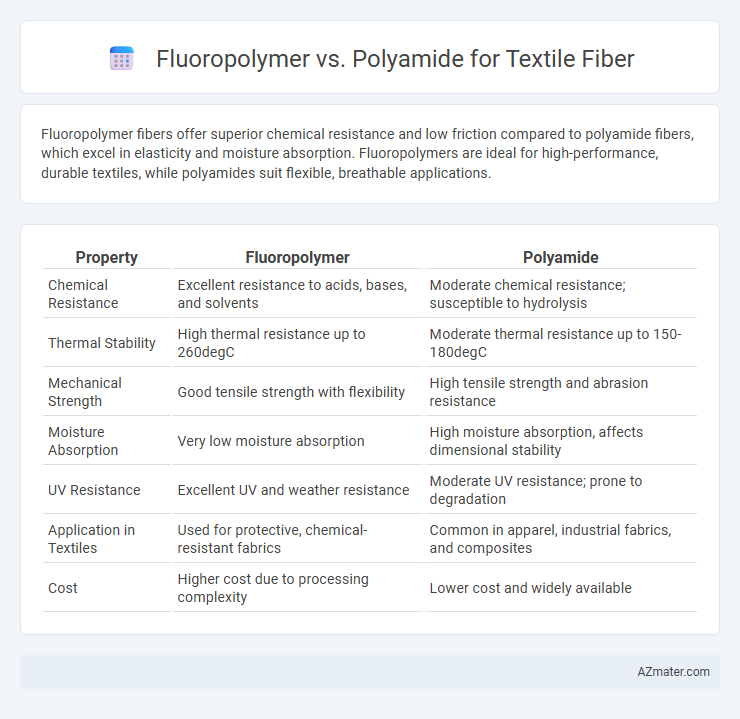Fluoropolymer fibers offer superior chemical resistance and low friction compared to polyamide fibers, which excel in elasticity and moisture absorption. Fluoropolymers are ideal for high-performance, durable textiles, while polyamides suit flexible, breathable applications.
Table of Comparison
| Property | Fluoropolymer | Polyamide |
|---|---|---|
| Chemical Resistance | Excellent resistance to acids, bases, and solvents | Moderate chemical resistance; susceptible to hydrolysis |
| Thermal Stability | High thermal resistance up to 260degC | Moderate thermal resistance up to 150-180degC |
| Mechanical Strength | Good tensile strength with flexibility | High tensile strength and abrasion resistance |
| Moisture Absorption | Very low moisture absorption | High moisture absorption, affects dimensional stability |
| UV Resistance | Excellent UV and weather resistance | Moderate UV resistance; prone to degradation |
| Application in Textiles | Used for protective, chemical-resistant fabrics | Common in apparel, industrial fabrics, and composites |
| Cost | Higher cost due to processing complexity | Lower cost and widely available |
Introduction to Fluoropolymer and Polyamide in Textile Fibers
Fluoropolymers in textile fibers offer exceptional chemical resistance, low surface energy, and excellent weatherability, making them ideal for protective and high-performance fabrics. Polyamides, commonly known as nylon, provide high tensile strength, elasticity, and abrasion resistance, widely used in apparel and industrial textile applications. Comparing these materials highlights fluoropolymers' superior durability and chemical stability, while polyamides excel in flexibility and cost-effectiveness for diverse textile uses.
Chemical Structure and Composition Comparison
Fluoropolymers consist of carbon-fluorine bonds, providing exceptional chemical resistance, hydrophobicity, and thermal stability, advantageous for high-performance textile fibers. Polyamides feature repeating amide groups (-CONH-) in their molecular backbone, imparting strength, flexibility, and moisture absorption properties suitable for wearable fabrics. The chemical structure differences lead fluoropolymers to excel in durability against harsh chemicals and heat, whereas polyamides offer superior mechanical flexibility and dyeability in textile applications.
Mechanical Strength and Durability
Fluoropolymer fibers exhibit superior mechanical strength and exceptional chemical resistance, making them highly durable under harsh environmental conditions compared to polyamide fibers. Polyamides offer good tensile strength and flexibility but tend to degrade faster when exposed to UV radiation and moisture, limiting their long-term durability in outdoor textile applications. The enhanced durability and resilience of fluoropolymer fibers result in extended fabric lifespan, especially in industrial and high-performance sportswear textiles.
Moisture Resistance and Water Repellency
Fluoropolymer fibers exhibit superior moisture resistance and water repellency compared to polyamide, due to their low surface energy and inherent hydrophobic properties that prevent water absorption and penetration. Polyamide fibers, while offering good mechanical strength and flexibility, absorb more moisture, reducing their effectiveness in wet or humid environments. The chemical stability and non-polar characteristics of fluoropolymer make it the preferred choice in textiles requiring durable water repellency and moisture barrier performance.
Thermal Stability and Heat Resistance
Fluoropolymer fibers exhibit superior thermal stability and heat resistance compared to polyamide fibers, maintaining integrity at temperatures above 260degC without significant degradation. Polyamide fibers, while offering good mechanical properties, typically withstand continuous use temperatures up to 150degC and tend to degrade when exposed to higher heat levels. The chemical inertness and high melting point of fluoropolymers make them ideal for textile applications requiring extreme thermal endurance and resistance to thermal aging.
Chemical and UV Resistance Properties
Fluoropolymer fibers exhibit superior chemical resistance, with exceptional stability against acids, bases, and solvents, maintaining integrity in harsh environments, while polyamide fibers tend to degrade when exposed to strong chemicals. In terms of UV resistance, fluoropolymers outperform polyamides due to their inherent ability to resist photodegradation, ensuring longer-lasting durability and color retention under prolonged sunlight exposure. These properties make fluoropolymer fibers ideal for high-performance textile applications requiring both chemical inertness and UV stability.
Flexibility and Comfort in Textiles
Fluoropolymer fibers exhibit exceptional flexibility and chemical resistance, making them suitable for performance textiles requiring durability and weather resistance. Polyamide fibers, such as nylon, offer superior elasticity and softness, enhancing comfort and wearability in everyday apparel. The choice between fluoropolymer and polyamide depends on the application's emphasis on flexibility or long-lasting comfort in textile products.
Environmental Impact and Sustainability
Fluoropolymer fibers, known for their chemical resistance and durability, present environmental concerns due to their persistence and difficulty in biodegradation, leading to microplastic pollution. Polyamide fibers, derived from petroleum, generate significant greenhouse gas emissions during production but offer better recyclability and biodegradability compared to fluoropolymers. Sustainable textile development favors polyamides with enhanced recycling technologies and bio-based alternatives to reduce environmental footprint compared to the more persistent fluoropolymer fibers.
Cost and Production Considerations
Fluoropolymer fibers exhibit superior chemical resistance and weather durability compared to polyamide, but their production involves higher raw material costs and complex processing methods, driving up overall expense. Polyamide fibers, commonly used in textiles, offer cost-efficient manufacturing with well-established production techniques and readily available materials, resulting in more affordable pricing. When selecting fiber materials, balancing the high performance and durability of fluoropolymers against the economic advantages and mass-production ease of polyamides is crucial for optimizing textile manufacturing budgets.
Applications and Future Trends in Textile Fiber Industry
Fluoropolymer fibers excel in high-performance textiles requiring chemical resistance, weatherability, and low friction, making them ideal for protective clothing, industrial filters, and outdoor gear. Polyamide fibers dominate everyday applications such as apparel, upholstery, and carpets due to their strength, elasticity, and moisture-wicking properties. Future trends indicate increased integration of fluoropolymers in smart textiles and sustainable high-performance fabrics, while innovations in bio-based polyamides aim to enhance environmental sustainability within the textile fiber industry.

Infographic: Fluoropolymer vs Polyamide for Textile Fiber
 azmater.com
azmater.com